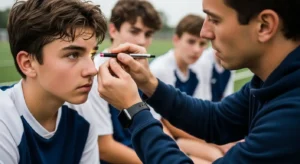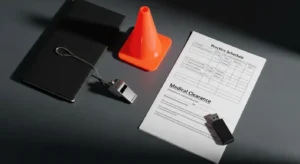Concussion safety in youth sports remains one of the biggest concerns for California parents in 2025. With new legislation under review and heightened awareness about head injuries, families want clear answers about what has changed, what is proposed, and how to keep their kids safe on the field.
Why Concussion Safety Matters
 Traumatic brain injuries (TBIs) are not limited to car accidents or falls. In youth sports, especially contact sports like football, soccer, and basketball, concussions are among the most common injuries. Even so-called “mild” concussions can affect learning, mood, sleep, and overall development if not treated promptly.
Traumatic brain injuries (TBIs) are not limited to car accidents or falls. In youth sports, especially contact sports like football, soccer, and basketball, concussions are among the most common injuries. Even so-called “mild” concussions can affect learning, mood, sleep, and overall development if not treated promptly.
California has been a leader in youth concussion safety, requiring removal from play and medical clearance before athletes can return. But in 2025, new measures are being debated and parents need to understand the landscape.
Key Legislative Updates in 2025
AB 310: The Nevaeh Youth Sports Safety Act
AB 310, also known as the Nevaeh Youth Sports Safety Act, is designed to strengthen safety measures for young athletes. The bill proposes:
- Emergency response plans for every youth sports program.
- Mandatory safety training for coaches and volunteers.
- Clear communication protocols with parents when a suspected concussion occurs.
Though not yet fully enacted, AB 310 reflects the growing demand for stronger oversight of youth sports safety programs across the state.
AB 749: Concussion Protocol Clarification
AB 749 focuses specifically on concussion management. It reinforces the principle of “when in doubt, sit them out” by requiring removal from play at the first sign of head trauma. It also mandates:
- Medical clearance before a young athlete can return to practice or competition.
- Updated information sheets for parents and athletes about concussion risks and recovery timelines.
- Consistency across leagues and organizations to ensure uniform safety standards.
This bill emphasizes education and standardization so that no child falls through the cracks due to uneven league policies.
The Youth Tackle Football Debate
California lawmakers previously considered banning tackle football for children under age 12. While that proposal stalled, the debate continues. Experts and parents remain divided: some believe full contact before high school is too risky, while others argue that strict rules and better coaching can make the game safer.
For now, parents should be aware that while tackle football is still legal, leagues are under increased scrutiny to follow concussion protocols and protect children from repeat injuries.
What Parents and Coaches Can Do Right Now
Even without waiting for new laws to take effect, families and coaches can adopt practical steps to protect young athletes:
- Know the warning signs: Concussion symptoms include headache, dizziness, blurred vision, sensitivity to light, confusion, memory issues, and sudden changes in mood or sleep patterns. Our post on TBI symptoms and treatment provides a helpful overview.
- Follow “when in doubt, sit them out”: If a child may have a concussion, remove them from play immediately and get a same-day medical evaluation.
- Document everything: Save injury reports, medical notes, and communications with coaches or league officials. Documentation protects both health and legal rights.
- Ask about league safety plans: Ensure your child’s league has an emergency plan, trained staff, and a clear return-to-play protocol.
- Keep baseline testing updated: Neurocognitive baseline tests help doctors measure recovery more accurately after an injury.
Legal Questions After a Youth Sports Concussion
When a concussion occurs, parents may face difficult questions about liability. In California, youth sports organizations have a duty to protect children, but legal issues can be complex. Potential challenges include:
- Comparative negligence: Insurance companies may argue that an athlete’s own actions contributed to the injury.
- Assumption of risk: Some organizations may claim that parents accepted the risks of sports participation.
- Negligence in supervision or medical care: Failure to remove a player after a head injury or ignoring medical clearance rules can expose leagues to liability.
Our overview of California brain injury laws explains key legal protections for families.
How a California Brain Injury Attorney Can Help
 When a child sustains a concussion, the priority is always health and recovery. But if negligence or safety violations played a role, families may be entitled to compensation for medical costs, future care, and emotional harm.
When a child sustains a concussion, the priority is always health and recovery. But if negligence or safety violations played a role, families may be entitled to compensation for medical costs, future care, and emotional harm.
At California Brain Injury Attorneys, we investigate how the injury happened, whether protocols were followed, and what evidence supports your claim. For guidance on building the strongest possible case, see our article on maximizing brain injury compensation.
Looking Ahead
As bills like AB 310 and AB 749 move forward, youth sports concussion safety in California will continue to evolve. Parents should stay informed, advocate for safety in their local leagues, and be proactive in protecting their children. Ultimately, the combination of strong laws, educated coaches, and engaged parents is what will keep kids safer on the field.
Key Takeaways
- California is considering new laws in 2025 (AB 310 and AB 749) to strengthen youth sports concussion safety.
- Parents should watch for concussion symptoms, demand proper protocols, and document every incident.
- Legal issues may involve negligence, assumption of risk, or improper supervision.
- A skilled brain injury attorney can help families protect both health and legal rights.
If your child suffered a head injury in sports, contact our team today for a free consultation. We can explain your legal options and help secure the resources your family needs.


